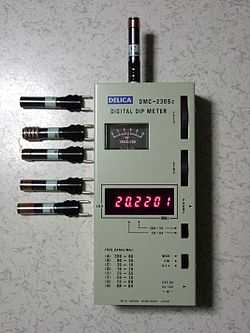Grid dip oscillator
- "Dipmeter" could also refer to an influential early commercial expert system called Dipmeter Advisor; or may refer to an instrument that measures the "dip angle" of the planet's magnetic field, the field line angle in a vertical plane.


Grid dip oscillator (GDO), also called grid dip meter, dip meter, dipmeter, or just dipper, is a measuring instrument to measure resonant frequency of radio frequency circuits. It measures the amount of absorption of a high frequency inductively coupled magnetic field by nearby objects. It is an oscillator whose amplitude changes when near a resonant circuit which is tuned to the frequency the oscillator generates. At the heart of the instrument is a tunable LC circuit with a coil that serves as a loose inductive coupling to the measured LC resonant circuit. Resonance is indicated by a dip in the meter indicator on the device, usually based on a microammeter.
History
Grid dip oscillators were first developed in the 1920s, and were built with vacuum tubes. The devices measured the value of the tube's grid current. Modern grid dip oscillators are solid-state devices and are more versatile. Solid-state versions of the grid dip oscillator are sometimes called gate dip oscillators or emitter dip oscillators in reference to the parts of the semiconductor whose current is being measured instead of the grid current on a vacuum tube.
Principle of operation

Central to the circuit is a variable frequency oscillator with interchangeable coil and tuning capacitors (ganged) as shown. When the oscillator's coil is in the vicinity of another resonant circuit, the pair behaves as a low Q transformer, especially if the respective resonant frequencies match; this affects the frequency and amplitude of oscillation of the GDO, which is sensed in any of several ways, the simplest of which is to attach an ammeter.[1]
Applications
Grid dip oscillators have been widely used by amateur radio operators for measuring the properties of resonant circuits, filters, and antennas.
See also
External links
| Wikimedia Commons has media related to Dipmeters. |
- Grid Dip Meters gallery